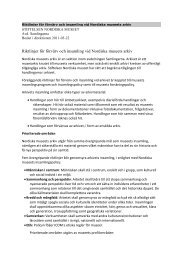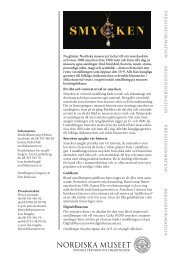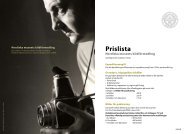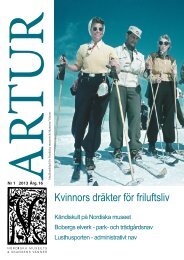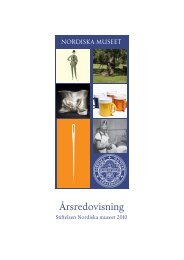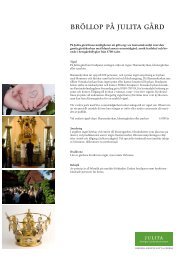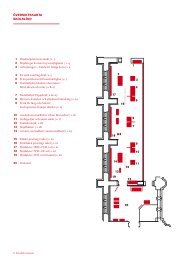Samdok - Nordiska museet
Samdok - Nordiska museet
Samdok - Nordiska museet
You also want an ePaper? Increase the reach of your titles
YUMPU automatically turns print PDFs into web optimized ePapers that Google loves.
connecting collecting: merritt<br />
The Internet has provided a way to separate physical<br />
from intellectual access in a way that really is a paradigm<br />
shift – one museums have not fully incorporated into<br />
their thinking and ways of operating. Research and interpretation<br />
increasingly start with electronically available<br />
data and images. Thus these activities can be partially<br />
divorced from the issue of who actually cares for the material.<br />
Museums mount digital information about their<br />
collections on the Web, and frequently mount digital exhibitions.<br />
Recent research by the Media and Technology<br />
Committee of the AAM shows that museums typically<br />
have twice as many visitors to their websites as they do to<br />
their physical museums. For some museums in the survey,<br />
the online audience was ten times more than their<br />
physical audience.<br />
And, if the main issue is to know where collections<br />
are and be able to access them (or access relevant information)<br />
would not this goal be as well served by putting a<br />
large chunk of these resources into electronic catalogues,<br />
metadata, search tools for knowing where this material<br />
is (whoever holds it), and then leverage access in other<br />
ways? Typically a museum only has 4 or 5 percent of its<br />
collections on exhibit. (Less, at a natural history museum<br />
with large research collections, more at an arts center<br />
with relatively small collections.) If museums are desperately<br />
overcrowded, as they say, perhaps there is a role for<br />
encouraging private owners of collections to make them<br />
publicly accessible. Such an alternate system or preservation<br />
and access could release museums of the sole responsibility<br />
of housing collections that benefit the public.<br />
As long as an object is accessible to exhibit designers,<br />
educators, and researchers, does it actually need to be<br />
owned by the museum? Particularly when museums report<br />
an acute dearth of adequate storage?<br />
This might be achieved through a system that encourages<br />
a donation of rights similar to land trust or<br />
building preservation easements. In such systems, the<br />
private owner gives up certain rights in return for a tax<br />
benefit. An organization, such as a land trust may exercise<br />
oversight or stewardship of such easements. Perhaps<br />
private collectors of art or antiquities could donate access<br />
rights to the public in return for tax breaks. A certified<br />
conservator and registrar could assess the works,<br />
their storage conditions, and documentation periodically,<br />
as prerequisite of the arrangement. The private owner<br />
would make information on the work publicly accessible<br />
via the Internet, perhaps on a national database of collections<br />
resources. And the owner would make the works<br />
accessible to scholars on a regular basis, as well as for<br />
public exhibition through loan to museums.<br />
Are museums caring for the right<br />
collections?<br />
The data cited above reveals the vast gap between the resources<br />
museum have and those they need to adequately<br />
care for this material. Before we can ask private donors,<br />
foundations, or the government to pour more money<br />
into taking care of these collections, they can rightly ask:<br />
does it all belong in a museum, is it worth our money to<br />
preserve? Unfortunately, the answer is a resounding ‘no.’<br />
Anyone who works in a museum, in the course of browsing<br />
through the storage rooms, or participate in an inventory,<br />
comes across something, probably a lot of somethings,<br />
which elicit the reaction ‘What in the world was<br />
someone thinking when they accepted this?’ Sometimes<br />
the thing itself does not belong in a museum; sometimes<br />
it is simply out of place in that particular museum. In fact,<br />
the US Accreditation Commission finds this is a widespread<br />
problem, even in high performing museums, and<br />
is collectively a huge drain on museum resources.<br />
This situation makes a certain sense. Many museums,<br />
in their founding and their operations, are driven by private<br />
goals, not a desire for the public good. Founders,<br />
donors, directors, curators, have their own motivations<br />
for building collections. Private collectors and museum<br />
founders often look for some form of immortality.<br />
Directors and curators gain professional status and<br />
the intellectual satisfaction of pursuing a private vision.<br />
None of these motivations are bad, but they do not necessarily<br />
best serve the public good. Look, for illustration,<br />
back to our examples of museums concentrating risk by<br />
holding comprehensive collections of individual artists.<br />
Definitely good for the museums’ reputations, maybe not<br />
so good for the public. Also, while sometimes the curato-<br />
20






